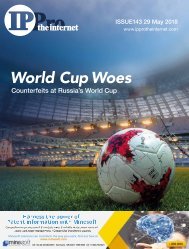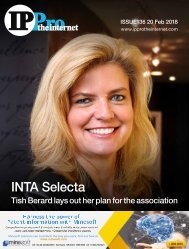IPPro Patents Issue 049
In this issue: Andrei Iancu confirmed as USPTO director
In this issue: Andrei Iancu confirmed as USPTO director
Create successful ePaper yourself
Turn your PDF publications into a flip-book with our unique Google optimized e-Paper software.
Patent Approaches<br />
acid sequence. For example, looking at US Patent 8,071,352,<br />
granted to Intron Biotechnology in 2011, we see a claim to “an<br />
isolated bacteriophage belonging to Myoviridae family, which has<br />
killing activity specific to Staphylococcus aureus, and the genome<br />
comprises sequences of SEQ ID. NOs:1-26”, with a sub-claim<br />
further defining the phage as “one that was deposited under the<br />
Accession No: KACC 97001P”.<br />
US law. Additionally, case law in Funk Bros Seed Company v Kalo<br />
Inoculant Co has made it difficult to obtain protection for novel<br />
phage cocktails.<br />
Consequently, it is likely that the product claims outlined above are<br />
no longer valid in the US, with the likely exception of the claim drawn<br />
to a modified phage.<br />
Although such product claims are unlikely to now be valid in the US,<br />
method claims in the US are now more acceptable. We now also see<br />
more claims drawn to consortia (for example “a panel of bacteriophage,<br />
wherein the panel comprises any one or more bacteriophage<br />
selected from the group”) and to modified phage. Look, for example,<br />
to US Patent 9,623,058, the principle claim in this patent being: “A<br />
Staphylococcus bacteriophage K mutant, which comprises one or<br />
more mutations within one or more of the following regions: a) the<br />
region between ORF 18 and ORF 19; and/or h) ORF 100.”<br />
With the US in mind, it is now useful when preparing new applications<br />
to include as much information relating to modifications or<br />
formulations of the phage. If a synergistic effect can be demonstrated<br />
from your cocktail, then this should also be included as it should help<br />
issues arising from Funk Bros.<br />
Of course, we should still be able to rely on protection in the US<br />
from claims drawn to methods of treating specific diseases with<br />
specified phage.<br />
Current challenges and looking to the future<br />
It is now difficult to obtain methods of use claims where the invention<br />
comes from the use of phage in general, rather than the use of<br />
specific phage. However, where we can argue that the general use<br />
of phage is novel and inventive in the context of the method, such<br />
claims should be pursued.<br />
Applicants are now more focused on developing specific therapeutics,<br />
and so will now more likely want to pursue product claims drawn<br />
to phage compositions that will be useful in therapy, with narrower<br />
claims drawn to the therapeutic uses of those phage.<br />
In Europe, the patent system is well disposed to such a strategy. The<br />
most significant problem in many current cases in Europe is having to<br />
demonstrate to patent examiners that a phage in a patent application<br />
is different to that in cited prior art. For this reason, it is advised to<br />
include as much characterisation data as possible in new filings,<br />
such as morphological and functional data.<br />
The US patent system is, however, perhaps the greatest current<br />
challenge. It is not presently possible to obtain patent protection in<br />
the US for ‘natural products’, which include isolated phage under<br />
Perhaps the biggest challenge comes from trying to future-proof your<br />
patent filings. A patent has the potential to provide protection for 20<br />
years, so we need to have an eye to the products of the future. With<br />
the interest in synthetic biology, will synthetic phage be the preferred<br />
therapeutic agent?<br />
Will phage that have been modified to remove genes that are not<br />
required (or potentially detrimental to full therapeutic potential) be the<br />
therapies of the future?<br />
If this is the case, we must ask ourselves if claims drawn to specific<br />
deposited phage, or to tightly defined nucleic acid sequence are<br />
broad enough to cover these future potential therapeutics.<br />
For that reason, we should try and be innovative in our claim strategies<br />
and our applications should push patent offices to accept more<br />
broadly defined phage (including modifications to those sequences).<br />
Finally, as this field becomes established, and the levels of<br />
competition in the market rise between the principle parties, we will<br />
no doubt see a corresponding increase in defensive and aggressive<br />
patent strategies. The field will then become more interesting, for<br />
perhaps a different reason. <strong>IPPro</strong><br />
Perhaps the biggest challenge comes from<br />
trying to future-proof your patent filings.<br />
A patent has the potential to provide<br />
protection for 20 years, so we need to have<br />
an eye to the products of the future<br />
Craig Thomson, partner, HGF<br />
9 <strong>IPPro</strong> <strong>Patents</strong> www.ippropatents.com







